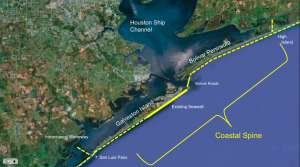
CLASP event highlights the importance of storm surge barrier to prevent flooding
After Hurricane Ike struck the Houston area Sept. 13, 2008, causing Texas $12 billion in damage alone, William Merrell, professor and chair of marine sciences at Texas A&M University Galveston, envisioned a solution to prevent another storm surge disaster. The project he brought to life has since become known as the Ike Dike concept.
The Clear Lake Association of Senior Programs (CLASP) sponsored an event on campus Dec. 3, 2015, titled, “The Ike Dike: A Coastal Barrier System Protecting Houston and Galveston Region from Hurricane Storm Surges.” The event speaker was retired Col. Len Waterworth, executive professor of maritime administration at Texas A&M University at Galveston and coordinator of the hurricane surge protection research activities for the project.

The Ike Dike concept is built on similar models found in the Netherlands that a group of visionaries visited in the early planning stages. It entails a coastal spine that will spread along the coast of Galveston with the goal of breaking the surge before it makes landfall, severely reducing its power and destruction through flooding by as much as 85 percent.
“This is one of those projects that has to be done because it keeps water out of our homes, our businesses, protects our environment and it saves people’s lives,” Waterworth said. “Hurricane Ike was a category-2 storm with a category-4 surge. It was the third costliest hurricane in U.S. history.”
The proposed dike’s coastal spine would reach from Sabine Pass to High Island. Additionally, it would feature an extension of the existing seawall along the coast’s dune line with two floodgates, one at San Luis Pass, the other at Bolivar Roads, which could be closed in case of an approaching storm. (See map.png)
“What we are trying to do is protect 6 million people,” said Bob Mitchell, president of the Bay Area Houston Economic Partnership.
Hurricane Ike had striking resemblances to the Great Storm of 1900 that hit Galveston. Both storms originated from the coast of Africa and produced a tremendous storm surge by the time they reached the U.S. coast. In response to the 1900 Hurricane, construction began on the Galveston Seawall in 1902 for protection against future hurricanes.
“[There were] accounts of 6-8,000 people perishing on the island [during the Great Storm],” Waterworth said. “And then, there was a reaction after the 1900 storm, and a seawall was put in.”
Although the seawall held during Hurricane Ike, it only protects a small stretch of land and fails to protect against back bay tides. Since its original erection, coastal erosion and land subsidence have also become an issue.
Hurricane Ike recorded a total of $30 billion in damages. It was responsible for at least 195 deaths, 112 of which occurred in the U.S.
“Ninety-two thousand homes were damaged in Harris County, close to 50 miles away from the coastline, because of the surge,” Waterworth said. “[The coastal spine concept is] essentially a 17-foot structure and gates at Bolivar Road to protect the water because it’s the cheapest, most effective way to mitigate damage to the majority of our people, a majority of the environment and a majority of our businesses.”
Waterworth also pointed out that the Port of Houston is the nation’s top exporting port. Forty-six percent of specialty feed stocks, 60 percent of gas, 80 percent of the Department of Defense jet aviation fuel and 60 percent of all other aviation fuel in the nation are all produced in the affected region.
“The importance of this is a national effort,” Mitchell said. “It’s not just protecting the assets of our region, it’s protecting the entire economy of the United States.”
Now that a majority of the initial research for the dike’s construction has been accomplished, the focus has shifted to finding key government figures to support the project.
“The problem is that the federal government is not going to put the money into [the Ike Dike] unless there’s a huge disaster, and that disaster is going to affect the entire United States,” Mitchell said.
Although one-sixth of the Texas economy comes from the Houston-Galveston Ship Channel, the federal government did not provide any additional appropriations to the U.S. Army Corps of Engineers to financially support studies and forms of protection after Hurricane Ike.
“Louisiana got $16 billion, $14 billion upfront and, six years after the storm, they had a surge barrier put in place,” Waterworth said.
The Ike Dike plan has therefore been modified to react, as opposed to its original focus, which was on the prevention of the next national disaster.
Mitchell and Waterworth, among others, have been engaged in reaching out to government officials in order to convey the importance of the Ike Dike concept. So far, more than 20 cities and municipalities have shown support for the project, and the number is rising. The CLASP event was yet another way to reach out to the community.
“We’ve been coming [to CLASP events] for a number of years,” said James Story, who was in the audience with his wife Annette.
Annette Story said the reason they have been avid visitors is to educate themselves about topics they would normally not know about. The events usually end in a discussion.
“I am always impressed with the questions, not only the number of them, but also the depth of them,” said Annette Story.
The monthly CLASP speaker events have provided a platform for seniors in the area to engage in a higher education with a variety of discussions and topics that are relevant in the community.
“This is, in a sense, gymnastics for the mind,” said Marilyn Lunney, a UHCL alumna and coordinator for the CLASP speaker event series. “We bring in speakers from all walks of life; they’ve been always the most accomplished I can find in the field.”
<iframe width=”560″ height=”315″ src=”https://www.youtube.com/embed/25FdudPf9vc” frameborder=”0″ allowfullscreen></iframe>
<iframe width=”560″ height=”315″ src=”https://www.youtube.com/embed/JOP6twDYptU” frameborder=”0″ allowfullscreen></iframe>
